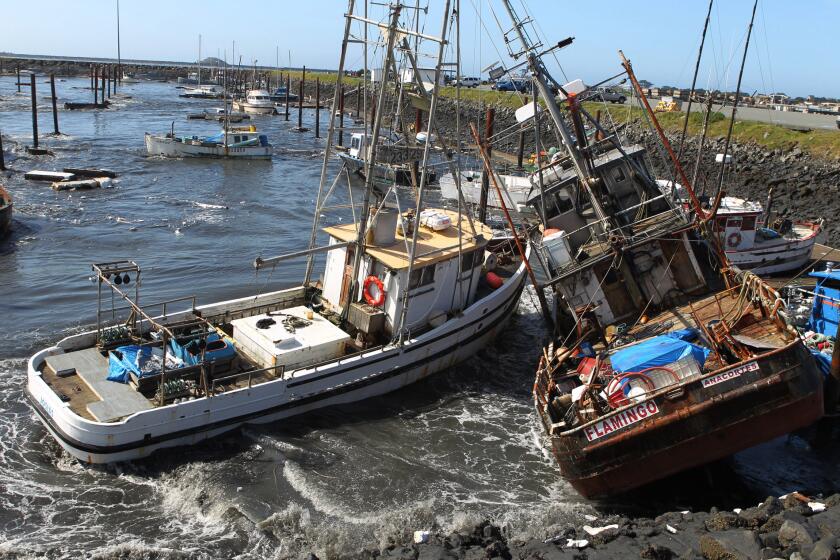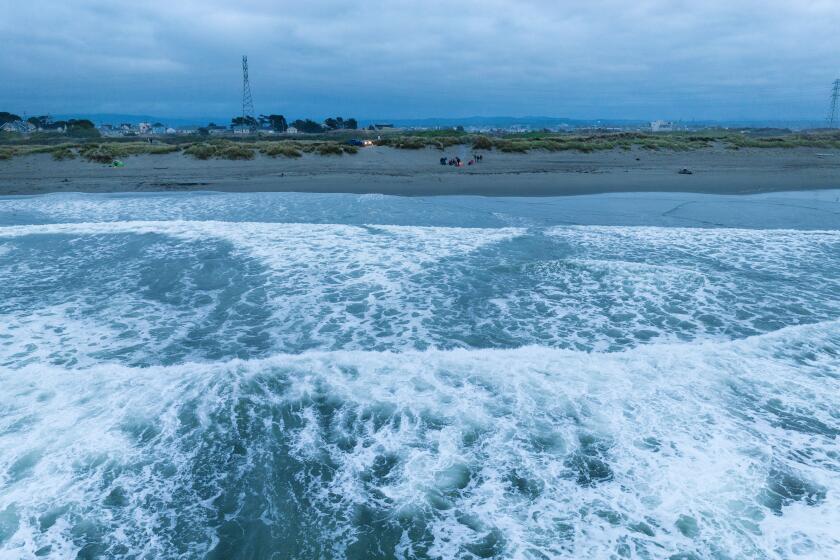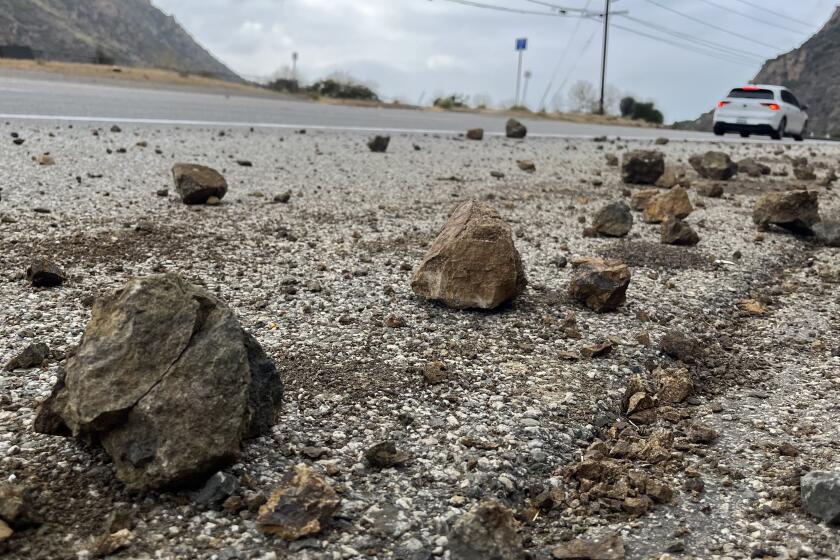7 California faults that could produce among the most devastating earthquakes

- Share via
In earthquake country, the meandering paths of quake faults easily get seared into memory in the same way as a California freeway map.
An earthquake fault is a fracture in the ground between two blocks of rock. They allow blocks of rock to move relative to each other, according to the U.S. Geological Survey, and when they move fast, that produces an earthquake. In California, the main tectonic forces driving earthquakes are the Pacific plate moving northwest relative to the North American plate.
Everyone knows about the San Andreas, the massive fault that was responsible for both the great 1906 San Francisco earthquake and the 1989 Loma Prieta quake. A quake from the San Andreas fault also could devastate Southern California — it last happened in 1857. Several disaster movies have tried to depict what would happen, including the 1978 “Superman” movie and the 2015 thriller “San Andreas” (with plenty of Hollywood fantasy).
You're reading Unshaken
Sign up to get our guide to preparing for an earthquake.
You may occasionally receive promotional content from the Los Angeles Times.
Over the last few decades, researchers have learned to better understand how faults work and to better predict the level of damage a major quake could produce. Their goal, scientists say, is to better prepare. Half a century ago, California lawmakers passed rules designed to prevent building right on top of active faults that reach the Earth’s surface.
Fractures in the ground can be mysterious. The 1994 Northridge quake occurred on an unknown blind thrust fault that never extended to the surface and hadn’t been mapped. The 2014 Napa earthquake also ruptured a fault that hadn’t been mapped.
But there are other major known faults capable of producing disastrous temblors that get little attention.
Here’s a look at some notable faults across California:
The San Andreas Fault stretches nearly the length of California
Location: More than 800 miles long, stretching from near the Mexican border in Imperial County, and continuing through the counties of Riverside, San Bernardino, Los Angeles, Kern, San Luis Obispo, Monterey, San Benito, Santa Clara, Santa Cruz, San Mateo, Marin, Sonoma, Mendocino and Humboldt.
Among the cities and communities that the San Andreas travels through are Coachella, Indio, Cathedral City, Palm Springs, Desert Hot Springs, Banning, Yucaipa, Highland, San Bernardino, Wrightwood, Palmdale, Gorman, Frazier Park, San Juan Bautista, Palo Alto, Portola Valley, Woodside, San Bruno, South San Francisco, Pacifica, Daly City and Bodega Bay.
Impact: A magnitude 7.8 earthquake on 300 miles of the southern San Andreas fault — from the Salton Sea (which is southeast of Palm Springs) to Lake Hughes (just west of Lancaster) — could result in 1,800 deaths, among the worst for a natural disaster in U.S. history. It could cause $213 billion in economic losses.
Earthquakes along the San Andreas in 1857 (Southern California) and 1906 (Northern California) probably were each an estimated magnitude 7.9.
The Newport-Inglewood/Rose Canyon fault runs under SoCal’s most densely populated areas
Location: The Newport-Inglewood fault runs from the border of Beverly Hills and Los Angeles, through Long Beach to the Orange County coast. This fault caused the 1933 Long Beach quake, a magnitude 6.4. Severe shaking, as defined by the Modified Mercalli Intensity Scale, was felt in places such as Long Beach, Lakewood, Paramount, Bellflower, Hawaiian Gardens, Los Alamitos, Seal Beach and Huntington Beach.
It continues as the Rose Canyon fault just offshore of the San Diego County coast, and comes ashore directly underneath La Jolla and heads into downtown San Diego.
Impact: The 1933 earthquake was Southern California’s deadliest in the modern record, leaving nearly 120 dead and causing $40 million in property damage. In the past, this fault has started earthquakes so violent they caused a section of Seal Beach to fall 1.5 to 3 feet in a matter of seconds.
Evidence suggests that earthquakes as large as magnitudes 6.8 to 7.5 have struck the Newport-Inglewood/Rose Canyon fault system. If a magnitude 7.5 earthquake were to rupture on the Newport-Inglewood/Rose Canyon fault system, such a temblor would bring massive damage throughout Southern California — producing 45 times more energy than the 1933 earthquake.
A plausible magnitude 6.9 earthquake along the Rose Canyon fault through the heart of San Diego would threaten the civic and financial center of California’s second largest city and the nation’s fourth-biggest naval base.
The Hayward fault puts much of the San Francisco Bay Area at risk
Location: The length of the East Bay from the San Pablo Bay through Richmond, San Pablo, El Cerrito, Kensington, Berkeley, Oakland, San Leandro, Castro Valley, Ashland, Hayward, Union City, Fremont, Milpitas and San José.
Impact: A report by the U.S. Geological Survey estimates that at least 800 people could be killed and 18,000 more injured in a hypothetical magnitude 7 earthquake that ruptures 52 miles of the Hayward fault between Fremont and San Pablo Bay. As many as 2,500 people could need to be rescued from collapsed buildings, and 22,000 people could be trapped in elevators.
The Hollywood fault is under many older mid- and high-rise buildings
Location: The fault runs roughly along or near segments of Sunset Boulevard through Beverly Hills and West Hollywood, parts of Hollywood Boulevard, Hillside Avenue, Franklin Avenue and Yucca Street through Hollywood and continues through Los Feliz as it crosses Interstate 5 en route to the Raymond fault, which starts in Atwater Village.
Impact: This fault is considered dangerous because it runs through many populated areas with older mid-rise and high-rise buildings. It can produce an earthquake as large as a magnitude 7.
The Raymond fault crosses multiple freeways
Location: The Raymond fault runs from Atwater Village, Glassell Park and Highland Park — at times along York Boulevard and Meridian Street — and then through South Pasadena, Pasadena, San Marino, East Pasadena, Arcadia and Monrovia. The fault crosses multiple freeways, including Interstates 5 and 210, as well as state Routes 2 and 110.
Impact: It can cause an earthquake as large as magnitude 7. It could produce catastrophic damage locally.
The Santa Monica fault cuts through the Golden Triangle
Location: The Santa Monica fault runs below Rodeo Drive and the Beverly Hills shopping district, cutting through the so-called Golden Triangle and running between Santa Monica and Wilshire boulevards, according to a state map published in 2018.
The fault roughly follows the path of Santa Monica Boulevard starting around the Westfield Century City mall to the grounds of the Mormon Temple in Westwood, then heads southwest through the Sawtelle neighborhood. As it continues, there are numerous splays of the fault in the city of Santa Monica, before it moves through Pacific Palisades and into the Pacific Ocean, just off the coast of Malibu.
Impact: An earthquake as large as a magnitude 7 is possible. There are many older buildings underneath the Santa Monica fault, and buildings that sit astride it are at risk of complete collapse.
It is also possible that the Santa Monica, Hollywood and Raymond faults could rupture in the same earthquake event.
Puente Hills thrust fault system could one day produce the costliest disaster in U.S. history
Location: The Puente Hills thrust fault system never reaches the Earth’s surface, and sits underground at an angle — shallowest about a mile south of USC, where it’s two miles under the surface, and deepest along the 210 Freeway corridor, where it’s about 10 miles deep.
The broad, roughly rectangular area directly on top of the fault system includes downtown Los Angeles, Pico-Union, Westlake, Echo Park, Silver Lake, Historic South-Central as well as Northeast L.A., the Eastside, Glendale, City of Commerce, Pico Rivera, Downey, Norwalk, Santa Fe Springs and La Mirada.
The fault system also underlies a wide swath of the San Gabriel Valley, including Pasadena, South Pasadena, Alhambra, Monterey Park, Rosemead, San Gabriel, San Marino, Temple City, El Monte, West Covina, Hacienda Heights, Rowland Heights, La Habra Heights, La Puente, City of Industry and Walnut. The fault system also underlies part of Orange County, including La Habra and Brea.
Impact: A magnitude 7.5 quake in the Puente Hills thrust fault system could kill 3,000 to 18,000 people, according to the U.S. Geological Survey and Southern California Earthquake Center. The economic loss could be up to $252 billion, which could be the costliest disaster in U.S. history.
Sign up for Essential California
The most important California stories and recommendations in your inbox every morning.
You may occasionally receive promotional content from the Los Angeles Times.













